Remington 700 VTR
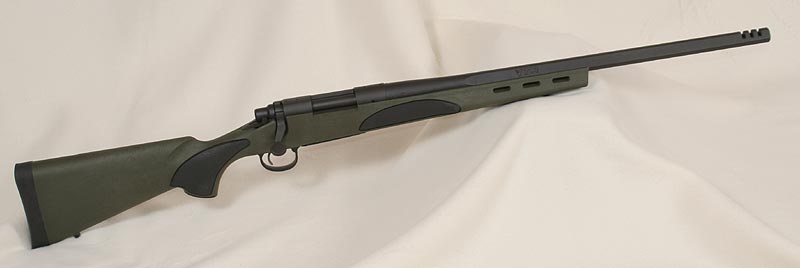
Remington 700 VTR - .308
|
| Caliber: | .308 Win (7.62x51mm NATO)
.223 Rem (5.56x45mm NATO)
.22-250 Rem
.204 Ruger |
| Barrel: | Remington Factory Heavy Contour, triangulated w/muzzlebrake |
| Barrel Length: | 22" (559mm) |
| Twist: | RH 1:12" (.308)
RH 1:9" (.223) |
| Empty Weight (without optics): | 7.5 lbs (3.41 kg) |
| Overall Length: | 41.625" (1057mm) |
| Magazine: | 4 (.308) or 5 (.223) round internal magazine |
| Trigger: | remington X-Mark Pro |
| Stock: | Injection Molded Plastic with rubberized inserts |
| Finish: | Matte Blue |
| Price: | $805 Suggested Retail (Street price should be less) |
Well, here we are, another new year, and another few new tactical models introduced by Remington. Of all the rifle makers out there, Remington seems to be the one taking the most advantage of the tactical rifle popularity by introducing a couple of new tactical rifles just about every year. One of the new ones this year is the Remington 700 VTR, or Varmint-Tactical Rifle. This particular rifle has a few new twists to make it unique and we ordered one in to test these new twists and see just what kind of a tactical rifle the VTR is.
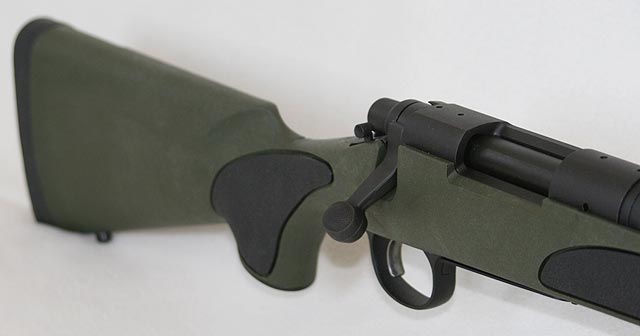
Yes, here is another Remington 700 with the same action as on all the other Remington 700's we have reviewed. There is not a whole bunch to talk about in regards to the 700 action that we have not covered in all the other Remington 700 tactical rifles and custom built rifle reviews we have done. But, there are some things that are different that makes this review worth doing. To me, I'm not really sure who the target customer is for this rifle, beyond the tacti-cool crowd. It is a lightweight and compact rifle design, but the last time I checked, Remington was quite successful with the 700LTR rifles as well as their extremely popular, and good performing,SPS Tactical rifle introduced last year. This rifle is about the same weight as those two and fits in-between in price. But the one thing this rifle does have that is different, is the very unique barrel profile and integrated muzzlebrake.
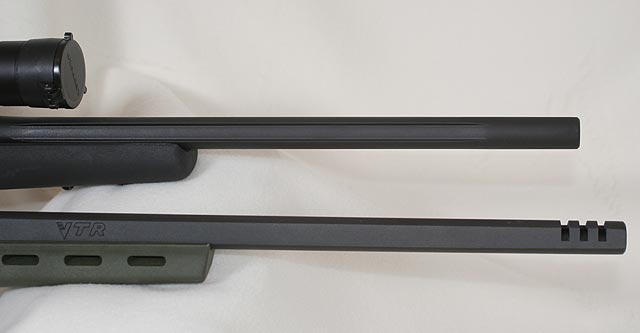
As you can see in the photo above and below, the profile of the barrel is not a round profile like a typical rifle barrel, but is triangulated. Essentially, what it appears to be is that Remington took the LTR fluting and continued the flute all the way out, making the barrel a triangle. Looking at this objectively, beyond saving weight, I do not see what this particular profile does? Unlike a traditional fluted barrel, you actually reduce the amount of surface area which hurts with heat dissipation and barrel cool down, and as far as I can tell, you are making the barrel less rigid which should lead to degraded accuracy, but I'll reserve that final judgment until after the shooting sessions. The triangle also gives a nice flat surface area where Remington engraved a nice looking VTR logo.
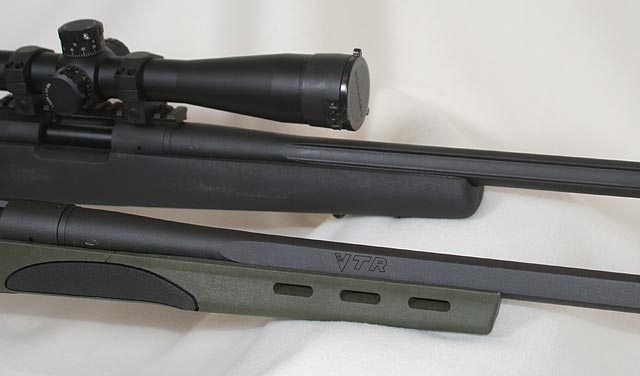
The other feature the VTR has that the LTR and SPS-T do not, is the integrated muzzlebrake. A well designed brake can reduce a lot of felt recoil as well keep the muzzle flip down helping with rapid follow up shots. This muzzlebrake has three large slots cut into the top of the triangle, angled slightly back to help "pull" the rifle forward, reducing the felt recoil and keeping the muzzle down. The brake is about 2" long and is not a part of the barrel, so in reality, the 22" barrel is really 20" effective inches, making it the same as the LTR and SPS-T.
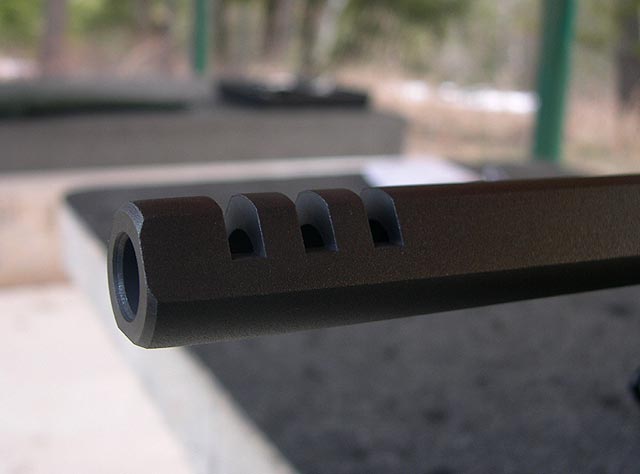
The stock on the VTR is the same stock that is found on the SPS Varmint rifle, but green instead of black, and they did make the inserts on the stock a rubberized material, which actually is a nice upgrade, but the stock is still injection molded and made of a fairly weak plastic and the barrel is not free floated as a result. It is fairly comfortable to shoot and the forearm is fairly wide and provides a stable enough shooting platform. It does have a Monte Carlo style cheekpiece, but it is not raised so it does not aide in bringing your eye in line with the scope like a normal raised Monte Carlo design does. Overall, like on the SPS Varmint, the stock is functional but nothing to write home about.
The VTR has the X-Mark Pro trigger which just about all Remington 700s have now. The trigger is fine, but I still prefer the old Remington trigger with its wider ribbed shoe and more options for adjustability. This one broke fairly clean right at 5 lbs. It is heavier than I like, but not bad for a factory trigger. The X-Mark Pro triggers do have a single adjustment that you can lighten the pull with, but we did not adjust the trigger at all for this evaluation.
The rest of the rifle is pretty much standard Remington 700. The action is as smooth as all Remington 700s, it has the same two position safety, the bolt release is in the same place, and it has the same extractor etc. So all the positives about a Remington 700 and all the negatives about a Remington 700 are there.
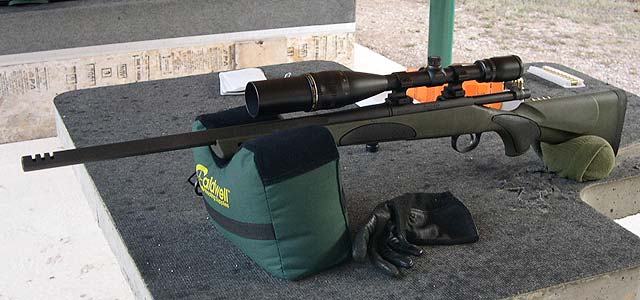
For the Shooting portion of the evaluation we mounted a Swift 6-18x50mm with mildots with a set of Burris XTR bases and Leupold Rings. We fired both standard Federal Gold Medal match and the nice HSM 168gr Match ammo. For zeroing the scope and doing some initial groups, the weather was terrible, which can happen in the spring in Montana. It was about 25 degrees with blowing snow. When we went back out for the performance evaluation, the weather was fairly nice at about 45 degrees in the early morning with calm wind, which made nice shooting conditions.
The first thing we noticed is that the muzzlebrake really was not that effective at reducing felt recoil. The rifle is fairly light, but not overly so, and the recoil on the rifle felt about the same as a LTR or SPS-Tactical. But the muzzle flip was less which did allow for quicker target acquisition after firing. I thought that the recoil reduction should be more than it was, as it did not seem to perform as well as most of the modern muzzlebrakes on the commercial market. Now, I will admit that we have no equipment for measuring the exact figure in terms of reduced recoil; this is just a personal comparison between rifles we have shot before.
The VTR shoots ok, but I would not say good, at least in comparison to the other heavy barrel Remington rifles available. We did manage to get one sub .5" group at 100 yards, but we had to really work at it. The small group of the day was .448", but the average group size of the good groups fired (meaning no obviously bad called flyers, etc) was only .858". This is not quite up to the normal accuracy we typically will see out of a 700P, LTR, SPS-Varmint, etc. I believe this is due to the drastic reduction of metal that is removed making the triangle barrel profile. Though the accuracy is still sub 1 MOA, it is just not what we have come to expect from Remington tactical/varmint rifles.
So, to conclude, how do we rate this rifle? Personally, I'm not sure what the target market is for the rifle, but I would not take it over any of the other Remington tactical type options out there. If I were looking for a short tactical rifle, I would much prefer to buy a LTR or even a SPS-Tactical where I would get a nicer stock and save some money while I'm at it, not to mention get better accuracy. The Muzzlebrake does not do quite enough to make it a real decision maker over the SPS-Tactical. Unfortunately, I just don't see the advantage of this rifle, but perhaps it'll fill a niche somewhere.
|
|
Return to rifle list
|
|
|
|
Tidak ada komentar:
Posting Komentar